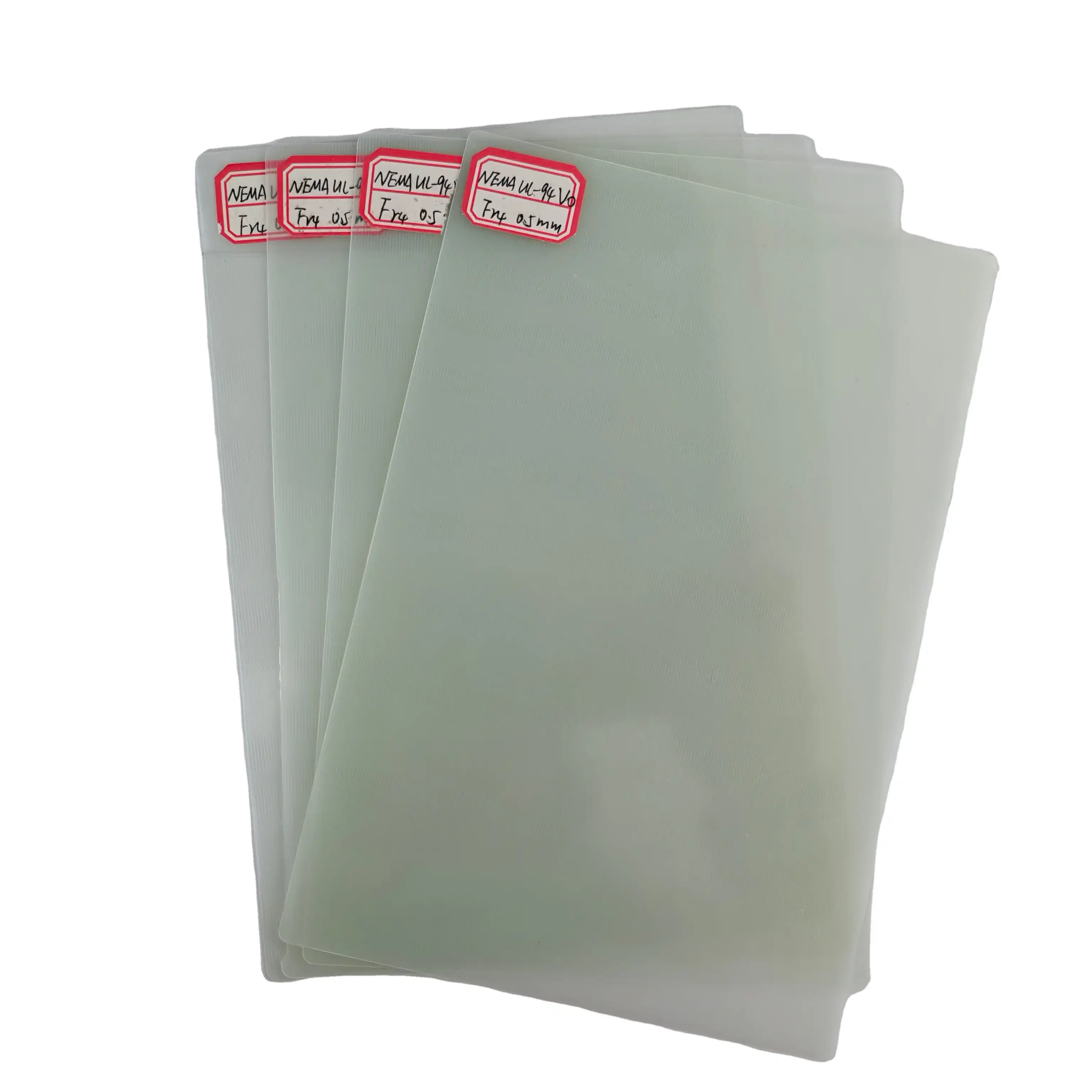The Composition and Properties of FR4
Chemical Composition of FR4
FR4, an abbreviation for Flame Retardant 4, is a composite material composed of woven fiberglass cloth impregnated with epoxy resin. The fiberglass provides structural integrity, while the epoxy resin acts as a binding agent and contributes to the material's electrical insulation properties. The precise composition may vary slightly between manufacturers, but typically includes 60-70% fiberglass and 30-40% epoxy resin. Additives such as brominated flame retardants are incorporated to enhance the material's fire-resistant qualities, crucial for ensuring safety in electronic applications.
Mechanical Properties
G10 sheet FR4 boasts impressive mechanical properties that contribute to its widespread use in PCB fabrication. It exhibits high flexural and tensile strength, allowing it to withstand the rigors of manufacturing processes and operational stresses. The material's low coefficient of thermal expansion ensures dimensional stability across a wide temperature range, preventing warping or distortion that could compromise circuit integrity. FR4's inherent rigidity provides excellent support for components and helps maintain the planarity of the board, crucial for reliable solder connections and overall performance.
Electrical Characteristics
The electrical properties of FR4 sheet make it an ideal substrate for PCBs. It possesses a high dielectric strength, effectively insulating conductive layers and preventing current leakage. The material's low dielectric constant and loss tangent contribute to signal integrity, minimizing signal distortion and attenuation, particularly at high frequencies. FR4 sheet's volume and surface resistivity remain stable across a broad range of environmental conditions, ensuring consistent electrical performance. These characteristics make FR4 suitable for applications ranging from simple consumer electronics to complex high-speed digital circuits.
FR4 in PCB Manufacturing
FR4 Sheet Preparation
The manufacturing process of FR4 sheets and G10 sheet begins with the careful selection of high-quality fiberglass cloth and epoxy resin. The cloth undergoes a meticulous cleaning process to remove any impurities that could affect the final product's performance. The epoxy resin is then applied to the fiberglass cloth through a precision-controlled impregnation process. This ensures uniform distribution of the resin throughout the fabric, eliminating voids or inconsistencies that could compromise the material's integrity. The impregnated sheets are then partially cured in a carefully controlled environment, resulting in a pliable state known as "prepreg." These prepreg sheets are then layered and fully cured under heat and pressure to create the final FR4 laminate, ready for use in PCB fabrication.
PCB Fabrication Techniques
FR4's versatility allows for various PCB fabrication techniques. The most common method involves photolithography, where a photoresist is applied to copper-clad FR4 sheets and exposed to UV light through a mask bearing the circuit pattern. The unexposed areas are then etched away, leaving the desired copper traces. For multilayer boards, several FR4 layers are bonded together using heat and pressure, with internal copper layers etched before lamination. Advanced techniques such as laser drilling for micro-vias and controlled depth routing take advantage of FR4's excellent machinability. The material's compatibility with both through-hole and surface mount technologies further enhances its utility in PCB manufacturing.
Quality Control and Testing
Rigorous quality control measures are essential in FR4-based PCB production to ensure reliability and performance. These include visual inspections for defects, thickness measurements, and dielectric strength tests. Sophisticated techniques such as time-domain reflectometry are employed to verify signal integrity. Thermal stress testing, including thermal cycling and thermal shock, evaluates the board's ability to withstand temperature fluctuations without delamination or warpage. Accelerated life testing simulates long-term use conditions to predict reliability. For high-reliability applications, additional tests such as insulation resistance measurement and CAF (Conductive Anodic Filament) resistance testing may be performed to ensure the FR4 substrate meets stringent quality standards.
Advancements and Alternatives to FR4
High-Performance FR4 Variants
As electronic devices become more sophisticated, demanding enhanced performance from PCB materials, manufacturers have developed high-performance variants of FR4 and G10 sheet. These advanced materials maintain the core benefits of traditional FR4 while offering improvements in specific areas. For instance, some variants feature lower dielectric constants and dissipation factors, making them suitable for high-frequency applications in telecommunications and aerospace industries. Other modifications focus on improving thermal management, incorporating materials with higher thermal conductivity to better dissipate heat in power electronics. Some FR4 variants are engineered for extreme environments, offering enhanced resistance to moisture absorption and improved performance at elevated temperatures, catering to automotive and industrial applications.
Emerging PCB Materials
While FR4 sheet remains the dominant material in PCB fabrication, emerging alternatives are gaining traction for specialized applications. Polyimide-based materials offer exceptional thermal stability and flexibility, making them ideal for flex and rigid-flex circuits used in compact electronic devices. Ceramic substrates, such as aluminum nitride and beryllium oxide, provide superior thermal conductivity for high-power applications. PTFE (Polytetrafluoroethylene) composites excel in high-frequency and millimeter-wave applications due to their low dielectric constants and loss tangents. Liquid crystal polymer (LCP) is emerging as a promising material for high-frequency, high-speed digital applications, offering excellent electrical properties and moisture resistance. These alternatives, while not replacing FR4 entirely, complement it by addressing specific needs in niche markets.
Environmental Considerations
The electronics industry's growing focus on sustainability has led to developments in environmentally friendly PCB materials. Halogen-free FR4 variants have been introduced to address concerns about the environmental impact of traditional brominated flame retardants. These materials use alternative flame retardants that achieve the necessary fire resistance without the potential environmental hazards associated with halogens. Bio-based epoxy resins derived from renewable resources are being explored as potential replacements for petroleum-based resins in FR4 production. Additionally, research is ongoing into PCB materials that are more easily recyclable at the end of their lifecycle, aiming to reduce electronic waste. These environmentally conscious innovations demonstrate the industry's commitment to balancing performance requirements with ecological responsibility.
Conclusion
FR4 sheet has solidified its position as the optimal material for PCB fabrication, offering an unparalleled combination of electrical, mechanical, and thermal properties. Its versatility, reliability, and cost-effectiveness have made it the backbone of the electronics industry. As technology continues to evolve, FR4 sheet and its variants adapt to meet increasingly demanding requirements, from high-speed digital circuits to power electronics. While alternatives emerge for specialized applications, FR4 sheet's dominance in mainstream PCB production remains unchallenged. The ongoing research and development in FR4 technology promise further improvements, ensuring its relevance in the ever-advancing world of electronics.
Contact Us
For more information about our high-quality FR4 sheets and other insulating materials, please contact us at info@jhd-material.com. Our team of experts, backed by over 20 years of experience in producing and selling insulating sheets, is ready to assist you in finding the perfect solution for your PCB fabrication needs.






